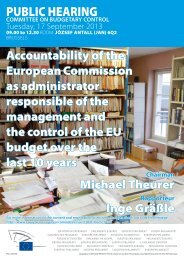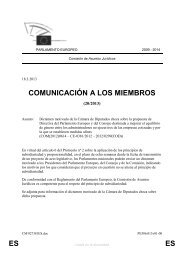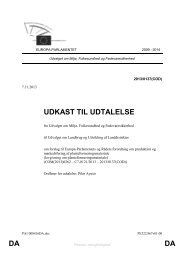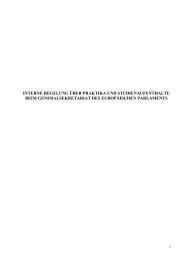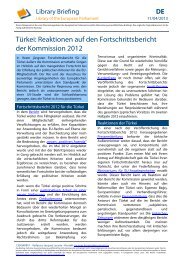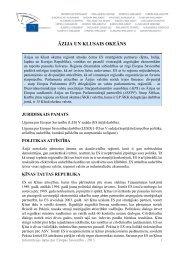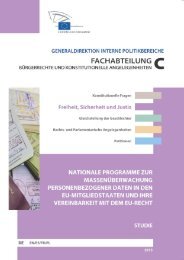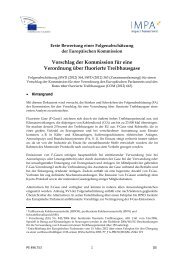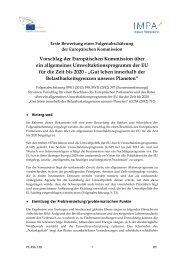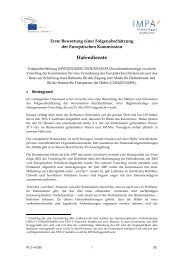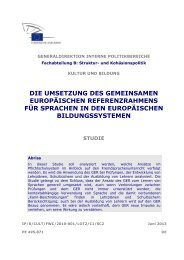Link to the study - European Parliament - Europa
Link to the study - European Parliament - Europa
Link to the study - European Parliament - Europa
You also want an ePaper? Increase the reach of your titles
YUMPU automatically turns print PDFs into web optimized ePapers that Google loves.
Policy Department D: Budgetary Affairs<br />
____________________________________________________________________________________________<br />
and tasks) is <strong>to</strong> allow removal of some or all of <strong>the</strong> regula<strong>to</strong>ry controls that apply <strong>to</strong> <strong>the</strong> nuclear<br />
facility while securing <strong>the</strong> long-term safety of <strong>the</strong> public and <strong>the</strong> environment, and continuing <strong>to</strong><br />
protect <strong>the</strong> health and safety of decommissioning workers in <strong>the</strong> process.' (AF-Colenco 2008)<br />
2.2.3. Basic strategic decision on decommissioning waste<br />
The process of removal of all activated and contaminated equipment is called decommissioning. As<br />
most of <strong>the</strong> physical materials of a reac<strong>to</strong>r were not affected by a considerable neutron flux and never<br />
got in contact with contaminated liquids (e.g. <strong>the</strong> electricity genera<strong>to</strong>rs), <strong>the</strong> amount of nonradioactive<br />
waste is much larger than <strong>the</strong> radioactive wastes.<br />
The fur<strong>the</strong>r steps in <strong>the</strong> decommissioning of a facility depend <strong>to</strong> a high degree on a basic<br />
management decision for all materials from controlled areas of <strong>the</strong> reac<strong>to</strong>r 3 :<br />
1. To minimize <strong>the</strong> amount of radioactive wastes later <strong>to</strong> be disposed of in a final disposal facility<br />
with a 'high' or 'excellent' isolation potential by extended separation and decontamination<br />
efforts. Material processing is designed <strong>to</strong> release as much as possible of <strong>the</strong> non-radioactive<br />
materials by applying radiological control release procedures and <strong>to</strong> handle ei<strong>the</strong>r <strong>the</strong><br />
unconditionally released material via conventional waste streams (e.g. steel and concrete<br />
recycling) or as conditionally released waste for specific use or conventional surface disposal.<br />
This strategy can, generally speaking, be termed as 're-concentration': <strong>the</strong> contamination that<br />
was previously spread over larger parts of <strong>the</strong> reac<strong>to</strong>r is concentrated in<strong>to</strong> a smaller fraction of<br />
wastes <strong>to</strong> be disposed of later in a specific disposal facility (final disposal).<br />
2. To separate only those activated and contaminated materials with an elevated content for later<br />
disposal in a facility with a medium or high isolation potential, <strong>to</strong> remove all materials that are<br />
obviously non-radioactive and <strong>to</strong> dispose all <strong>the</strong> rest of materials in a disposal facility with a low<br />
isolation potential. Under this mode rooms, equipment and items of <strong>the</strong> facility are simply<br />
characterized in<strong>to</strong> three categories: 'no activation/contamination', 'small or scattered<br />
contamination' and 'high contamination'. Only <strong>the</strong> first category leaves <strong>the</strong> site heading for<br />
conventional waste streams, while <strong>the</strong> latter two categories are disposed of in a designated nearsurface<br />
or geologic disposal facility.<br />
It is obvious that management route no. 1 means extensive efforts in decontamination as well as<br />
measuring materials and items with small concentration levels and a sophisticated administrational<br />
scheme <strong>to</strong> prevent erroneous release of radioactive items <strong>to</strong> uncontrolled conventional material<br />
streams, while route no. 2 means <strong>the</strong> opposite and disposes large amounts of only slightly<br />
contaminated material unnecessarily as waste. The terms 'high', 'medium' and 'low' isolation potential<br />
also need clarification, because decommissioning wastes by no means consist only of 'short-lived' 4<br />
3<br />
Equipment, items or buildings from areas not under radiological control can, if not needed any more, be<br />
re-used or removed in a conventional way.<br />
4<br />
Short-lived radionuclides have a short half life time, such as roughly 5 years for Cobalt-60 in activated or<br />
contaminated steel. In disposal, those radionuclides, if mobilized by corrosion, washout or o<strong>the</strong>r<br />
mechanisms, absorb on geologic layers and are decayed before any of <strong>the</strong> nuclides enter accessible<br />
surface water streams.<br />
40



